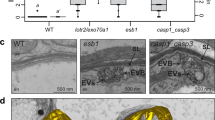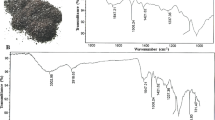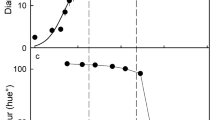Abstract
IN the course of an investigation into the origin of phenolic substances in ray parenchyma (Wardrop and Cronshaw, in preparation), it has been observed that some of these substances appeared to originate in structure limited by a double membrane, the form and dimensions of which are similar to those of amyloplasts, frequently observed in this tissue (Cronshaw and Wardrop, in preparation). Fig. 1 shows a transverse section of a ray cell from Eucalyptus elaeophora after fixation with potassium permanganate. The pattern of distribution of phenolic substances was observed to be the same after fixation with the ferrous sulphate-formaldehyde fixative for tannins described by Johansen1 although the cytoplasmic organelles were destroyed. In relatively mature material most of the cells had an appearance similar to that in Fig. 1 in which the iron staining or phenolic material showed poor fixation and penetration of the embedding medium. In younger material from the region adjacent to the cambium it was observed that phenolic substances were present in vesicles enclosed within an organelle which resembled a chloroplast, the regular structure of which had been disrupted. In Fig. 2 three of these vesicles can be seen associated with lamellæ resembling the grana of normal chloroplasts. Further observations showed that these vesicles arose by the dissolution of starch grains within the modified chloroplast or the amyloplast, and that as the dissolution took place the phenolic substances were deposited around the periphery of the vesicle so formed (Fig. 3), until the whole vesicle became filled with the phenolic material (Fig. 4). At an advanced stage of differentiation the amyloplasts, or the modified chloroplasts, could be seen to be undergoing disintegration and the released phenolic substances were aggregated in great concentration at the periphery of the vacuole (Figs. 4 and 5). In cells in which the vacuole was large, the organelles were confined to the narrow border of cytoplasm (Figs. 5 and 6).
This is a preview of subscription content, access via your institution
Access options
Subscribe to this journal
Receive 51 print issues and online access
$199.00 per year
only $3.90 per issue
Buy this article
- Purchase on Springer Link
- Instant access to full article PDF
Prices may be subject to local taxes which are calculated during checkout
Similar content being viewed by others
References
Johansen, D. A., Plant Microtechnique (McGraw-Hill, New York, 1940).
Sperlich, A., “Das tropische parenchym. B. Exkretungewebe” Linsbauer Handbuch der Pflanzenanatomie, 4, Lief. 38 (1939).
Hillis, W. E., and Carle, Ann, Biochem. J., 74, 607 (1960).
Haberlandt, G., Physiological Plant Anatomy (Macmillan, London 1914).
Zavalishina, S. F., Akad. Nauk S.S.S.R. Dok., 78, 137 (1951).
Author information
Authors and Affiliations
Rights and permissions
About this article
Cite this article
WARDROP, A., CRONSHAW, T. Formation of Phenolic Substances in the Ray Parenchyma of Angiosperms. Nature 193, 90–92 (1962). https://doi.org/10.1038/193090b0
Issue Date:
DOI: https://doi.org/10.1038/193090b0
This article is cited by
-
Correlation of the temporal and spatial expression patterns of HQT with the biosynthesis and accumulation of chlorogenic acid in Lonicera japonica flowers
Horticulture Research (2019)
-
Co-occurrence of tannin and tannin-less vacuoles in sensitive plants
Protoplasma (2016)
-
The Role of Sucrose in Regulation of Trunk Tissue Development in Betula pendula Roth
Journal of Plant Growth Regulation (2006)
-
Localization of ferruginol, a diterpene phenol, in Cryptomeria japonica heartwood by time-of-flight secondary ion mass spectrometry
Planta (2005)
-
Production of concentrated polyphenols by the root cap cells ofCorylus associated withTuber: ultrastructural study and element localization using electron energy loss spectroscopy and imaging
Trees (1995)
Comments
By submitting a comment you agree to abide by our Terms and Community Guidelines. If you find something abusive or that does not comply with our terms or guidelines please flag it as inappropriate.



